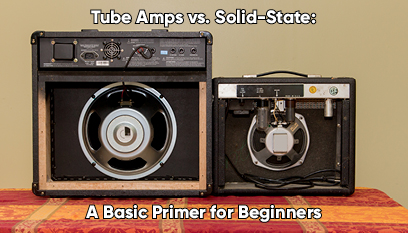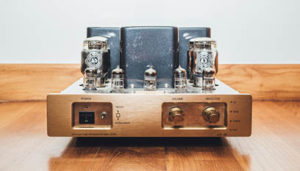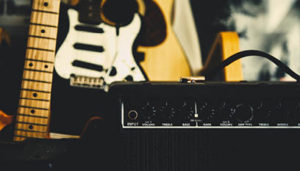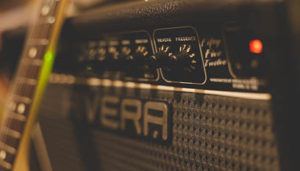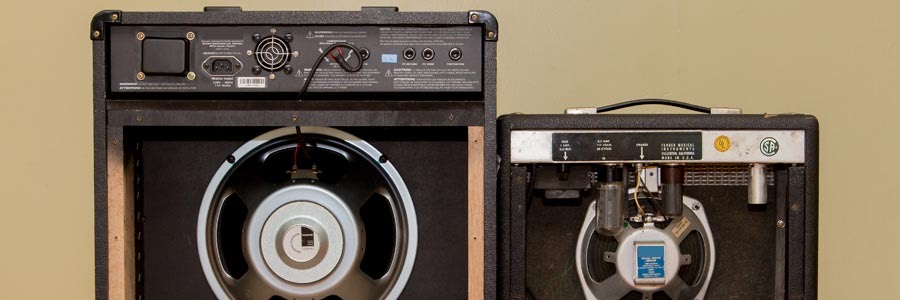
I’m sure you’ve noticed that tube amps have quite a cult following. New guitar players may wonder if it’s all marketing and snobbery, or if there really is something magical about these amps. To understand the obsession with tube amps, you first have to understand what exactly tube amps are and how they differ from other, newer amplification technologies. (The magic part is up to you.)
While the technology behind them is quite old, tube amps are popular with guitarists today because of the warm, natural tone created by the vacuum tubes inside the amps. Tube amps also have a considerable amount of old-school cred, as all the classic rockers and blues guitarists from the 60s were playing through tube amps. Basically, tube amps contributed to the tones that a lot of guitarists grew up worshipping.
Disclaimer: This post is meant to provide a very basic, non-technical overview for players like me who want to understand these concepts, but lack a background in physics or the desire to argue in online forums.
What’s a Tube Amp?
Back in the day, all amps were tube amps (or valve amps, as they are known in the UK). No other amp technology existed in the 50s and 60s. Like the TVs of the same era, these amps contained glass tubes with a vacuum inside.
Tube amps have never been cheap. The components have to withstand high heat and high voltage, so they are relatively expensive to make. Originally, all the wiring was done by hand. Nowadays hardly anyone is still using vacuum tube technology in mass manufacturing, which drives up the cost of tube amps.
The tubes can be a little finicky and can get damaged if the amp is bumped hard enough. Tube amps need a little bit of time to warm up, and they can react badly to low temperatures. The good news though is that tube amps, like most older technology, were built to last. A well-cared-for tube amp will stay with you for a long time. You may have to replace a tube every few years, though, because they burn out eventually.
(Examples: VOX AC30, Fender Champ)
What’s a Solid-State Amp?
Solid-state (SS) amps have resistors instead of tubes. They’re called solid-state because the electrical current moves through solid metal instead of a vacuum. This technology took off in the early 1970s, and led to all kinds of electronics becoming cheaper, smaller, and lighter. That’s because those transistors needed less voltage and created far less heat than tubes did. The first solid-state amps sounded cold and sterile, leading to a stigma that has persisted for decades even as the technology improved.
Today there are two main types of solid-state amps: pure SS amps and modeling SS amps.
Many SS amps are low-end models marketed to beginners, which isn’t surprising since SS amps are much easier to make than tube amps are. But there are also plenty of high-end SS amps! It’s certainly not fair to compare the little SS practice amp that came with your first electric guitar to a boutique tube amp.
(Examples: Roland JC-120 — which I got to know quite well in my high school music classroom, LAB Series L5 — played by BB King)
Recently manufacturers have started making modeling SS amps, which use digital technology to imitate the sound of well-known tube amps. (Purists, of course, will insist that nothing beats the real thing.) Basically, these amps take a solid-state amp and add software to it. Many also include a variety of effects, so in theory one amp could replace a more traditional amp and a bunch of pedals. Some modeling amps allow you to program your settings and switch between them very easily. A beginner just starting out may appreciate the versatility of modeling amps — although, like multi-effects pedals, they can be a little confusing.
(Examples: Line6 Pod, Boss Katana line, Fender Mustang, Roland Cube)
Hybrid Amps
Hybrid amps try to combine the best features of both amplification methods. They use tube pre-amps with a solid-state power amplifier. Some prominent British amp makers like Vox and Orange have been popularizing this species of amps, impressing players with what many consider a best-of-both-worlds approach to tone.
(Examples: Vox Valvetronix, Orange MicroDark and MicroTerror)
Tube Amp vs. Solid-State: Which is Better?
The tube vs. solid-state debate is part of the larger debate about analog vs. digital. A lot of people think tube amps just sound better, in the same way that a vinyl record sounds better than a digital recording.
The word most commonly associated with tube amps is “warmth.” Lots of people love the warm tones they get from tube amps. An overdriven tube amp sounds pleasant and musical. An overdriven SS amp will sound terrible in a hurry!
How much this matters to you likely depends on the music you play. If you play rock or blues, or you just like a lot of overdrive and distortion, you will probably prefer tube amps. A jazz guitarist may not care as much.
Solid-state amps do have many practical advantages, though. In general (and yes, there are plenty of exceptions), solid-state amps are physically lighter, more rugged, less expensive per watt, and less temperamental than tube amps. They also tend to offer more features and built-in effects. Many people find that solid-state amps are more convenient for playing quietly, because that distinctive tube-amp sound is really a form of distortion and it doesn’t happen at very low volume. In addition, players who switch between many different genres of music (or just don’t play a lot of blues or classic rock) tend to appreciate the clean, predictable nature of solid-state amps and the high headroom.
Investing in a Tube Amp
Tube amps are usually more expensive, but they’ll last forever when properly maintained. Quality tube amps hold their value amazingly well — have you seen the prices people are getting lately for vintage 60s tube amps?! — while solid-state amps can become dated as digital technology continues to improve.
Solid-state, modeling, and hybrid amps are also inherently harder to fix due to the electronics involved. It’s easy to open up a tube amp and see that a tube needs to be replaced — it’s not that different from a light bulb.
The Adjustment Period
Another reason people love tube amps is that they are responsive. A solid-state amp will be immediate and consistent no matter how hard you rock out, but a tube amp will react to your playing in a way that is hard to appreciate until you’ve tried it.
When I got my first tube amp, I felt like a whole new world of dynamics opened up for me that I never knew existed — but first week or two was a little disorienting. I had always varied my strumming strength based on the song. But because I had been playing an SS amp, the actual volume didn’t vary very much. The disorientation quickly passed, though, and I grew to love my tube amp. I have no desire to go back.
What About Bass?
Bass players usually prefer solid-state amps, because they tend to play clean at high volumes. Overdriven bass tone just isn’t very popular as a primary setting. Bass amps also require more power than guitar amps do. To get enough wattage for bass, tube amps have to be huge and extremely heavy. Unless you have money to burn and roadies to haul your gear around, a tube bass amp may not be worth it.
Other posts that may interest bass players include Should You Learn Guitar or Bass First? and Using Guitar Pedals With a Bass).
The Bottom Line
That’s a quick-and-dirty explanation of the main differences between tube amps and SS amps, so the next time you see some heated forum discussion about tube amps you’ll know what all the fuss is about. As with all aspects of guitar tone, what really matters is what sounds good to you – not guitar nerds on the internet.

